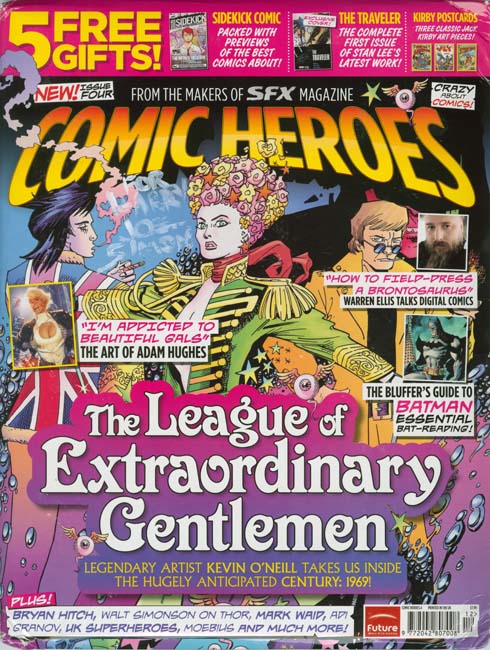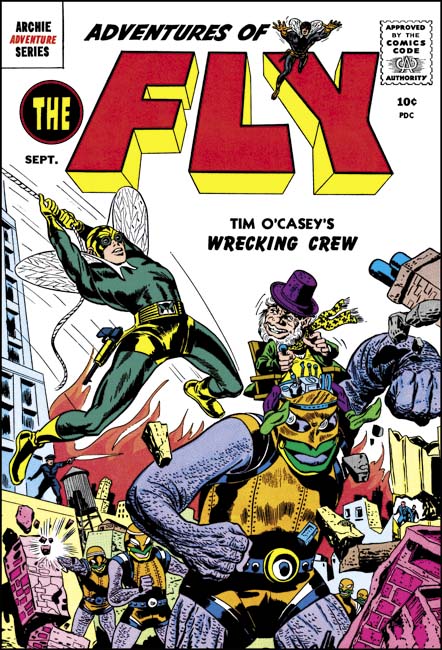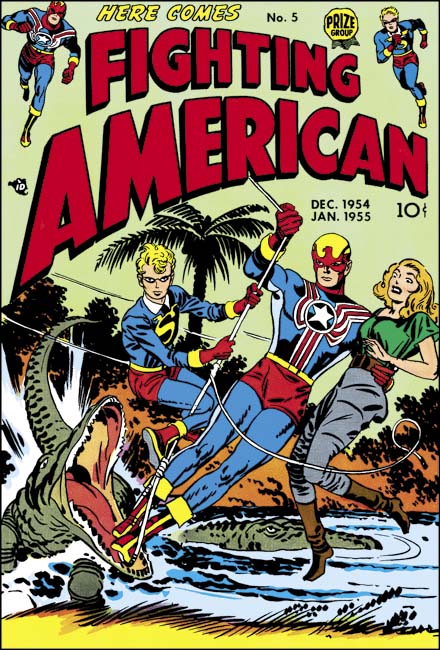Comic Heroes #4 includes three pieces of promotion for the Titan’s “Simon and Kirby Superheroes”. In the package are three postcards using Simon and Kirby covers (the restorations of which were done by yours truly). It is a really clever use of comic book covers and they are sure to be come a collector’s item. Below I show the images used (I am too lazy to scan the actual cards but take my word they look just as good).
Category Archives: 2011/03
Simon and Kirby Colorists, Chapter 1, Hillman
Generally little is known about the comic book colorists during the golden age. Credits usually were not provided and while pencilers and inkers would sometimes leave signatures there was no outlet for colorists to make their contribution known. Occasionally there is documentary evidence about particular colorists but largely they remain anonymous. None the less I have begun to investigate coloring done on Simon and Kirby productions. I may not be able to identify all the colorists but I am still interested in seeing what can be learned about the effect different colorists had upon the comics.
Currently I have been examining interior coloring. Covers were typically handled by different printers than the interior pages. The special paper and attention given to covers allowed the use of colors and tonal gradations that did not appear in the interior art. Both the cover and interior art was printed using cyan, magenta, yellow and black inks (CMYK). In general, CMYK printing allows a wide range of colors to be represented. Actually not every color can be created by combinations of the CMYK inks but those that cannot are a very small part of the color spectrum and are so close to colors that can be printed by CMYK that their absence is difficult to notice.
However the interior art in comic books was printed using a very limited palette. CMYK printing achieves color tones by the amount of area the ink covers. Typically, and this will be true of all the comics I will be discussing here, interior inks were limited to three tones 100%, 50% and 25%. It is possible to use 75% ink tones but printers find it difficult to do properly with the primitive presses and poor quality paper used for comic books. I have seen 75% tones used in comic books but it is quite rare and with a special exception to be discussed below it was not done in the books I will be discussing.
There are further limitations. No tones were used for the black ink. Actually this was not too limiting because black tones, that is the grays, can be achieved using combinations of CMY inks. Another limitation is that none of the comics I will be discussing use 50% yellow. I have seen it done elsewhere but again it is very rare. With three levels of cyan and magenta, two levels of yellow and one level of black it is possible to create at most 48 colors* (including white, the absence of any ink). The palette is actually even more limited in practice since about a dozen are rarely used. Most are combinations that include 25% yellow.
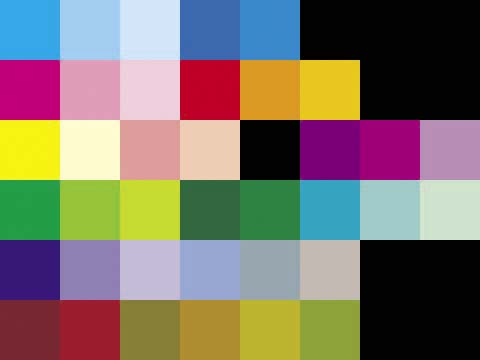
Generalized Comic Color Palette
C, C50, C25, CM50, CM25, X, X, X
M, M50, M25, MY, YM50, YM25, X, X
Y, Y25, M50Y25, M25Y25, X, MC50, MC25, M50C25
CY, YC50, YC25, CYM50, CYM25, CY25, C50Y25, C25Y25
CM, C50M50, C25M25, C50M25, C50M25Y25, C25M25Y25, X, X
MYC50, MYC25, YC50M50, YM50C25, YC25M25, YC50M25, X, X
Referring to colors as, for example, 100% yellow plus 50% magenta plus 25% cyan (brown), is somewhat tiring. The industry uses a designation which I find confusing so instead I will adopt my own using the first initial followed, if not 100%, by the percentage. So my brown example would be YM50C25. I always placed them in the order of dominance or (when two inks are equally strong) the order they are found in CMY. While this is an improvement it is still too difficult to use lists of such color designations when comparing palettes used. So I have also developed a matrix to show the color palettes. I show above the standard color palette that I will be using followed by the corresponding color designations (where an X indicates an unused matrix location shown as black). If a color is not used in a particular palette it will be ‘X’ out in the matrix. The first row is for blues; the second for reds; the third row for yellows, flesh colors and purples; the fourth row for greens; the fifth row for violets and grays; and the sixth for browns and one dirty green (YC50M25). In the future I will either use some of the currently undefined matrix locations or add additional rows for colors not included in the current matrix.
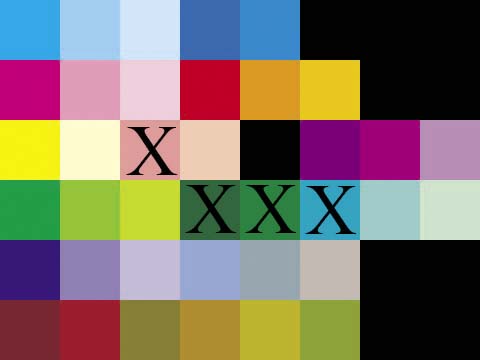
Color Palette used by Hillman in Clue and Real Clue Comics.
Joe Simon has said that the coloring was the responsibility of the publisher. There was a period (cover dates March to September 1947) where Simon and Kirby were producing work for crime comics from two different publishers; Clue Comics and Real Clue Crime Stories for Hillman and Headline Comics for Prize. It would therefore be interesting to compare the coloring between the two. The Simon and Kirby work produced for Clue and its renamed title Real Clue used a more complete palette than those for Headline. The Hillman work used 38 colors (excluding black and white). But this is a little misleading because some of the colors were rarely used; deep blue (CM50), some of the purple tints (MC25 and M50C25), and red brown (MYC25).
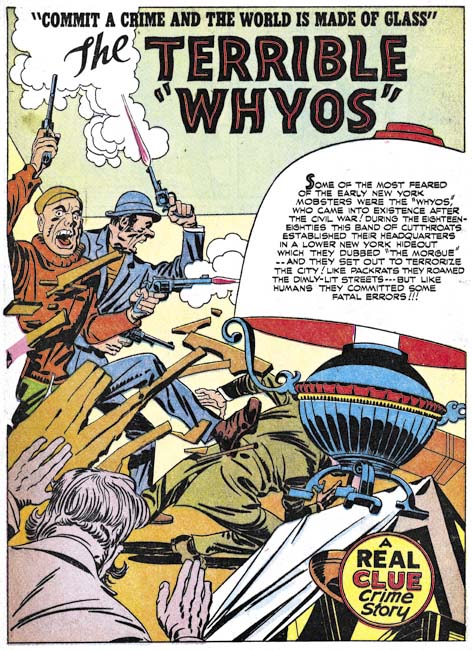
Real Clue Crime Stories v.2 n.5 (July 1947) “The Terrible Whyos”, pencils and inks by Jack Kirby
Perhaps the most distinctive feature of the Hillman palette was the common use of light yellow (Y25). We will see that this color was not used in Prize’s Headline Comics. Considering how most colors that include Y25 are avoided, it is surprising how often light yellow (Y25) was used. In one case Y25 was used for an automobile but it seems a poor choice for coloring prominent objects. However light yellow was generally used for background areas and it was surprisingly effective in making accompanying white areas stand out.
As mentioned previously, red brown (MYC25) was rarely employed but the other browns (dark MYC50, heavy YC50M50, medium YM50C25 and light YC25M25) were more frequently used. However not equally so as light brown (YC25M25) was not used nearly as commonly as the other three browns. Another not so frequently used color was dirty green (YC50M25).
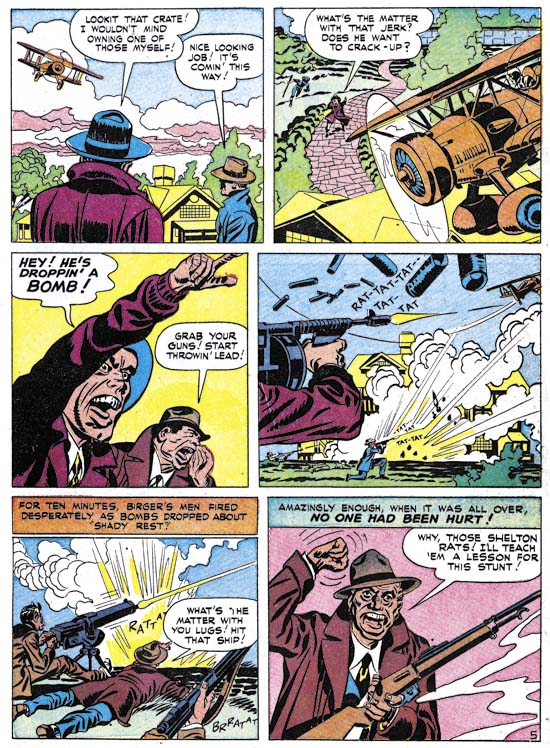
Real Clue Crime Stories v.2 n.7 (September 1947) “Gang War” page 5, pencils by Jack Kirby
Besides light yellow (Y25) the only other unusual colors with frequent use from the Hillman palette are pale green (C25Y25) and dark grey (C50M25Y25). Frankly with the very limited palette available for comic books the presence or absents of particular colors are of limited use in distinguishing different colorists. Also of use is how the artists uses the colors for the different objects. For instance the Hillman colorist generally uses middle green (YC50) for foliage and only much more rarely green (CY) or pale green (C25Y25). Police uniforms are dark blue (CM25) with brown shoes or boots. Caption boxes were colored with a variety of light colors; yellow (Y), light yellow (Y25), pale green (C25Y25), light orange (YM25) and even white. Desks and chairs are usual have a single color; generally dark brown (YMC50), heavy brown (YC50M50) or light brown (YM50C25).
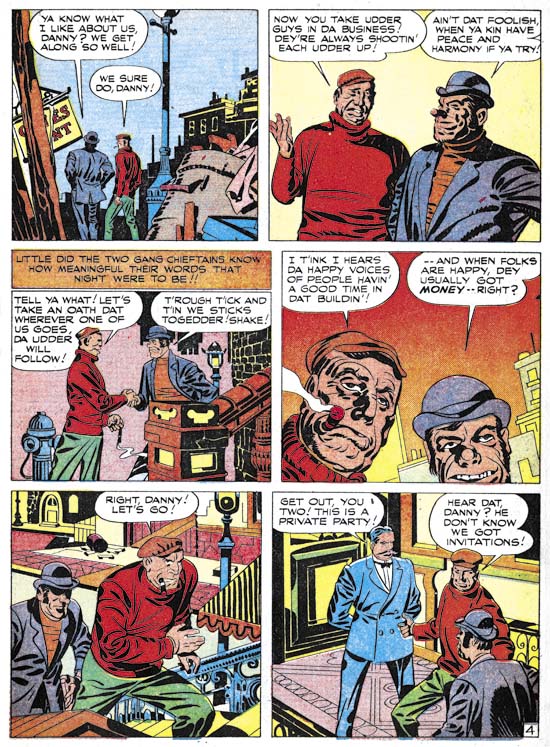
Real Clue Crime Stories v.2 n.5 (July 1947) “The Terrible Whyos” page 4, pencils and inks by Jack Kirby
Most golden age colorists were more concerned with providing clarity to a scene by providing the different objects with distinct colors. Realistic coloring was not a high priority. So with the Hillman colorist we get such oddities as multi-color sidewalks, pale green buildings and some really bizarre interiors. Not very realistic, but all more interesting than if a more realistic, and therefore more limited, selection of colors were used.
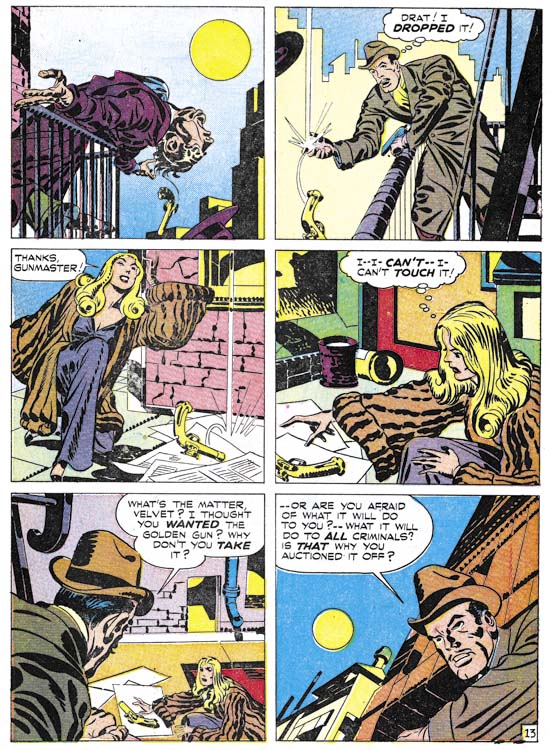
Real Clue Crime Stories v.2 n.6 August 1947) “Get Me the Golden Gun” page 13, pencils and inks by Jack Kirby
As previously mentioned, golden age colorists did not generally use graduated color tones for interior art. That is colors were restricted to mixtures of 100%, %50 or %25 of the cyan, magenta or yellow inks. But there was an exception to this rule and that was the use of simple color gradient usually to the background. The Hillman colorist made use of this varying a one ink of a color from 75% to 25%. Usually this was done rather smoothly but occasionally less care was taken. This was the sole exception that the Hillman colorist made to not using a 75% ink. The use of a starting value of 75% was not a whim. With the primitive presses used for comic books, 75% would sometimes fill in and become effectively 100%. If this happened to a gradient that started at 100% then a poor gradient would result with over much of it a pure color. With gradients starting at 75% any similar filling in would still provide a suitable gradient.
Although I have concentrated on the coloring of the Simon and Kirby pieces, the same colorists seemed to work on the stories drawn by other artists as well. The pencilers and inkers for Clue and Real Clue were used in other Hillman comics and were not the same ones that Simon and Kirby used for Prize’s Headline Comics. I therefore believe that Simon and Kirby were just supplying art to Hillman and not producing the entire comic as they were doing for Prize. I will compare the Hillman colorist to that used for Prize’s Headline Comic next week.
footnotes
* the complete comic color palette for three levels of cyan and magenta, two of yellow and a single of black. Those marked with asterisk are not shown in my standard comic palette:
K CMY25* CM
C50MY C50MY25* C50M
C25MY C25MY25* C25M
MY MY25* M
CM50Y CM50Y25* CM50
C50M50Y C50M50Y25* C50M50
C25M50Y C25M50Y25* C25M50
M50Y M50Y25* M50
CM25Y CM25Y25* CM25
C50M25Y C50M25Y25 C50M25
C25M25Y C25M25Y25 C25M25
M25Y M25Y25 M25
CY CY25* C
C50Y C50Y25 C50
C25Y C25Y25 C25
Y Y25 W
I’m Back
After more than three weeks, my telephone and Internet are working once again. I will not bore you with the details but suffice it to say it was not Verizon’s finest hour.
I will resume normal posting next week but in the meantime I will take this opportunity for some short posts one of which I have been meaning to write for some time.
My long absence is particularly annoying because while I was gone my blog received a surge of traffic. This surge occurred around March 5 and 6 but was very short lived. My number of visitors became five times my normal daily rate to reach a new all time high. Because I did not have access to my blog at that time I am unsure what occurred but there are hints that it might be related in some way to Will Eisner.
Simon and Kirby Blog’s Fifth Anniversary
Although hard to believe, it is true that I have been writing the Simon and Kirby blog for five years. Five years on the efforts of just two comic book artists, Joe Simon and Jack Kirby. Perhaps that is a little misleading because Joe and Jack were more than just artists, they produced comics as well. In doing so they employed other artists who have also been discussed on this blog as well. But still five years writing about a rather narrow topic. But guess what, I ain’t done yet!
It has been another banner year for Simon and Kirby. Titan released the first volume of the Simon and Kirby library, “The Simon and Kirby Superheroes”. I am completely biased (having done the art restorations) but it is an amazing book and (considering the number of pages) at a surprisingly low price. It provides a good overview of Simon and Kirby’s long collaboration. The book also gives a chance to see Joe Simon as a penciler on the Vagabond Prince, one of the more unusual superheroes of all time. DC has continued its Simon and Kirby archives with a Newsboy Legion and a Boy Commandos volume with more to come.
The previous year has also seen the publication of a book on Mort Meskin (“From Shadow to Light, The Life and Art of Mort Meskin” by Steven Brower). Brower has done a excellent job on an unjustly overlooked artist. Meskin was an important contributor to Simon and Kirby productions (second only to Jack) but of course he did great work both before and after his time in the Simon and Kirby studio. There have been a number of important volumes on comic book artists put out during the last year but in my opinion the must haves are Titan’s Superheroes and Brower’s Meskin books.
The Jack Kirby Comics Weblog is the place to go to see what is coming in Kirby related publications. Bob even beats me out in reporting on books that I work on! He as recently reported on Titan’s upcoming “Joe Simon: My Life In Comics” . Use that link to see two of the proposed covers for that book. I have seen a third but I do not know what the actual published cover will be. I have heard on the Internet comments to the effect that some already have “The Comic Book Makers” and will pass on this latest volume. That is all well and good but I want to make clear that “My Life In Comics” is NOT “The Comic Book Makers” revisited. “My Life In Comics” has stories that, to my knowledge, have never been reported before. Bob has also announced the next Titan addition to the S&K Library, “Simon and Kirby Crime”. It is too early for me to talk about this book but I will say that the actual release date is likely to be later then what is given by Amazon.
It has been a great five years for the Simon and Kirby Blog. I have by no means exhausted what I want to write about my favorite collaborators and the artists who worked for them. Further considering what is going to be published, the future should be interesting as well.
Joe Simon and Jack Kirby on the Internet
I am a bit late, but there are some Simon or Kirby related items on the Internet that I thought my readers might like to know about.
It has been on the Internet for a long time, but Simon Comics has been redone. If that is not enough, there is also the new Joe Simon Studio. Not enough Joe Simon? Then check him out on Facebook. I just cannot get over the fact that Joe Simon is on Facebook. I have to admit I am a 20th century guy and I just do not quite get what Facebook is all about. But Joe has inspired me to try to join the 21st century.
But what about Jack Kirby? Well there is the new Jack Kirby Discussion Group. Frankly there was an old Kirby list that had gotten to be a rather unfriendly site and I personally am glad to see it go. This new Kirby group is public and a friendly place to be. Also What If Kirby has returned to the Internet. It is a great place to visit particularly because of all the Kirby original art provided. Currently there are 400 pieces of Kirby art shown but it keeps growing. Simon and Kirby fans should check out the splash page from Captain America Comics #6.
A lot has been going on in the Kirby copyrights legal fight during my absence from the Internet. I have not had a chance to catch up but one of my favorite blogs, 20th Century Danny Boy, seems to be covering it quite nicely.


